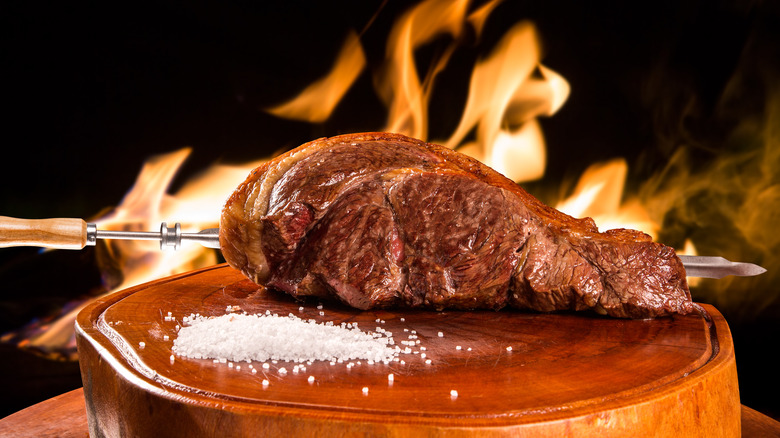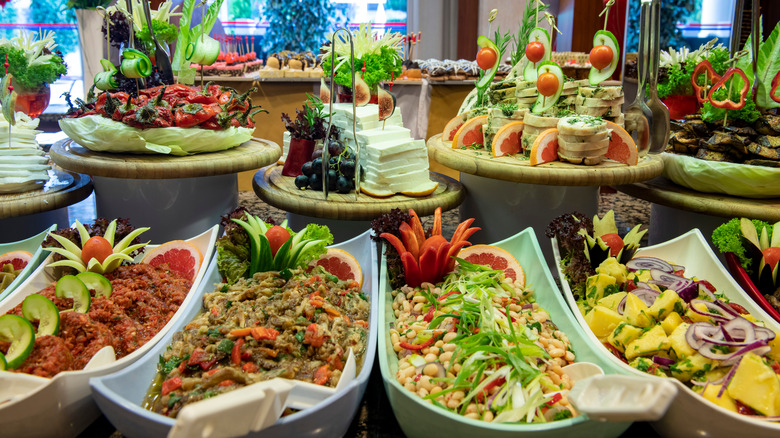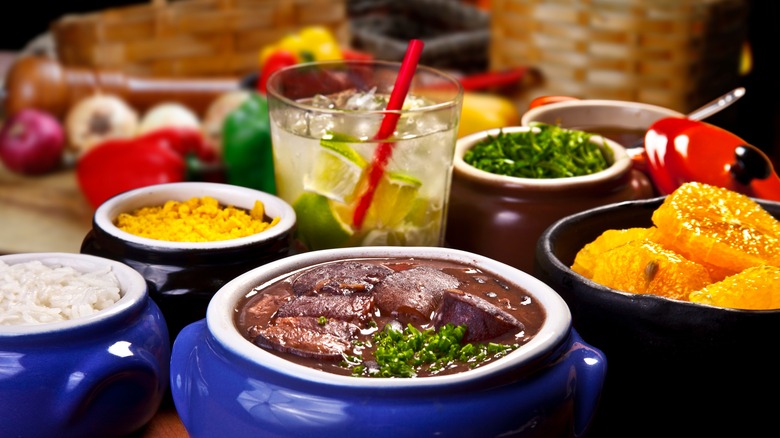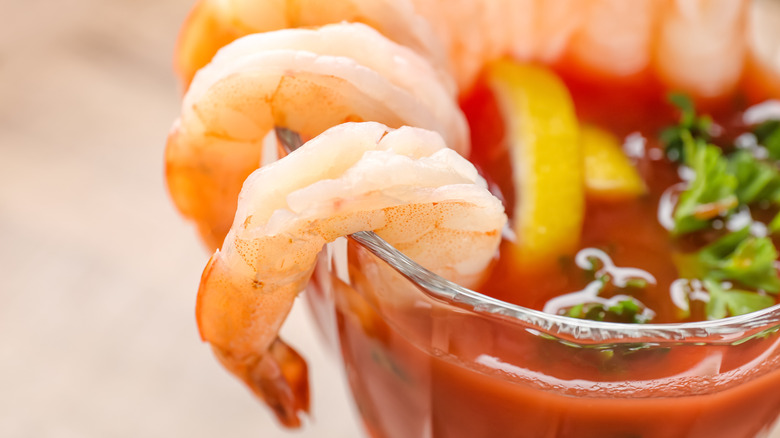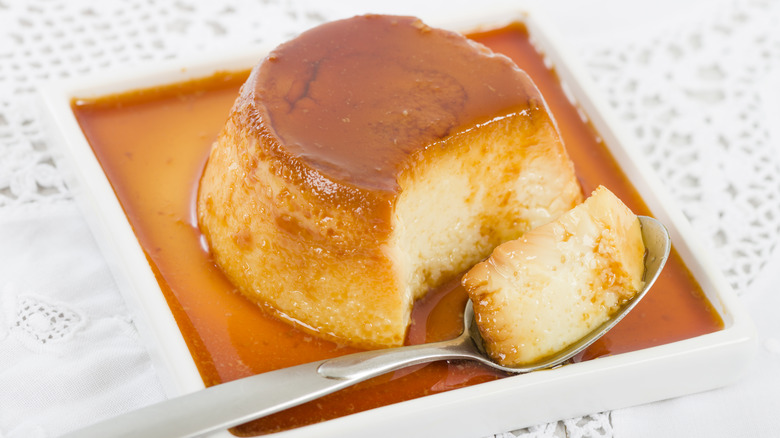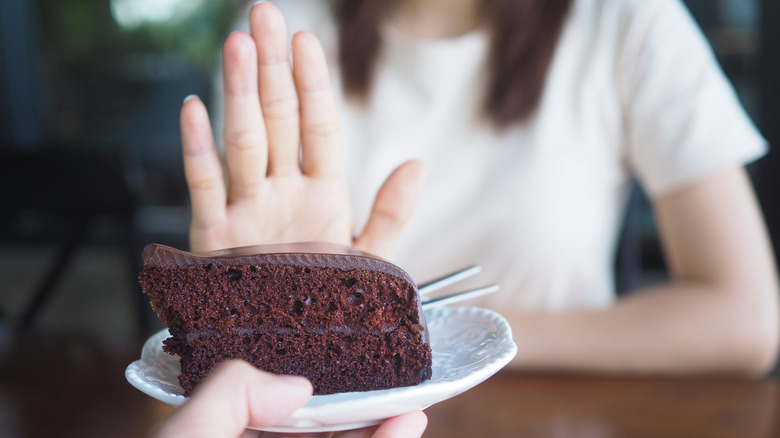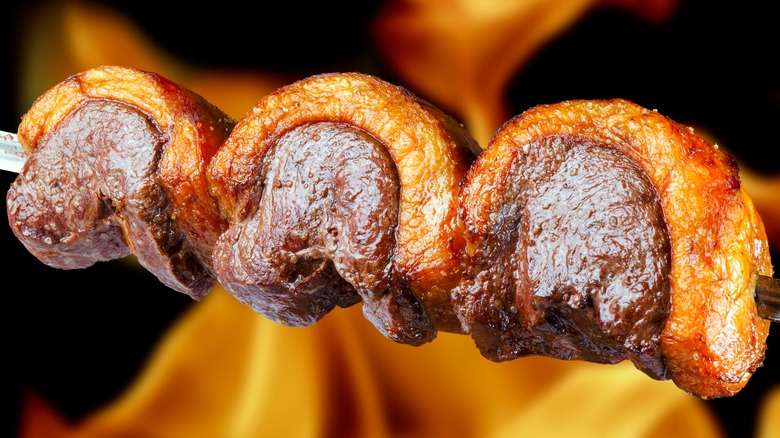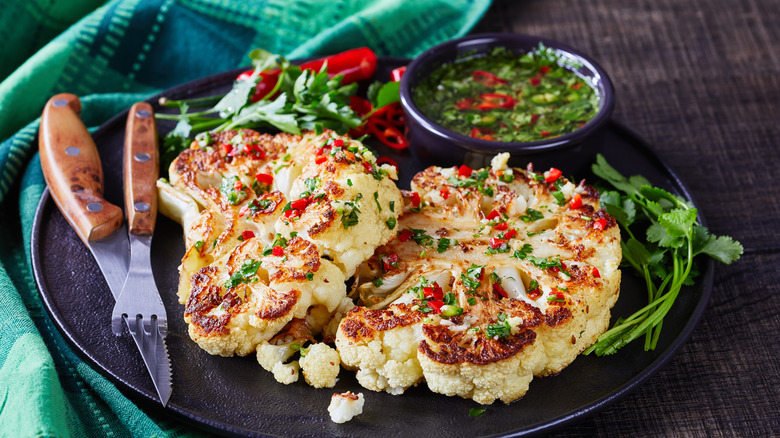A Beginner's Guide To Brazilian Barbecue
Brazilian barbecue, or churrasco, isn't just a style of eating — it's a way of life. It originated in southern Brazil in the late 1800s, when gauchos, or Brazilian cowboys, would herd their cattle throughout Rio Grande do Sul. These gauchos would periodically pause to create feasts of various cuts of meat, which were skewered and then slow-roasted over blazing embers from a fire pit they dug. This tradition has morphed into what is known as a "Rodizio-style" restaurant. Rodizio translates to "rotation" in Portuguese, which aptly represents what these restaurants are — a perpetual parade of meat and other items served on skewers by gauchos table-side in an all-you-can-eat extravaganza.
Serving barbecue in the Rodizio style may have been popularized in Brazil but has become available in restaurants across the globe. These establishments all work essentially the same way. You pay a flat price for the meal, which includes all the meat you can consume, an extensive salad bar, and several hearty side dishes. While each restaurant is slightly different in its offerings, the basics are the same. Navigating the evening takes a bit of preparation and some strategy to get the most bang for your buck. If you follow this guide and go in with the mentality that this is dinner and a show, you most certainly will have the dining experience of a lifetime.
Don't fast beforehand
Contrary to popular belief, fasting before consuming a big meal, like one you will experience at a Brazilian barbecue restaurant, is not a good idea. It's an instinct many of us tend to have. It happens every Thanksgiving when we skip breakfast and then gorge on Turkey and sides. We inevitably end up in a food coma and miss half the football game.
According to Catholic Health, fasting is problematic because it can leave you dehydrated and cause you to overeat, making you less likely to pace yourself during a big meal. You are far better off consuming smaller meals with plenty of protein throughout the day. Experts also recommend that you eat a light breakfast to jump-start your metabolism. And don't forget to drink plenty of water. Popular Science also suggests getting in a workout to help whet your appetite and get your digestive system moving.
And above all, don't stress over it. Going out to eat shouldn't be the source of anxiety, which can be counterproductive to a good appetite. One meal won't make or break your diet. Plan to have fun while experiencing the myriad of incredible flavors, smells, sights, and sounds you will experience while dining at a Brazilian barbecue restaurant.
Do your homework
Even though the basics of a Brazilian barbecue restaurant are the same, each restaurant will have its distinct specialties, sides, additional menu items, desserts, beverages, and prices. While some elements of surprise can be fun, we recommend at least getting familiarized with the menu and what to expect from the specific restaurant where you will be dining. You'll want to know the cost and what that includes so that you don't inadvertently order something that isn't a part of the fixed price.
You may also want to know how many items will be a part of your Rodizio rotation. Most of these restaurants will have 10 to 15 options, although we have been to places with as many as 20. And finally, you will want to be clear about any rules or limitations on the time or quantities of a particular item. Generally speaking, this will not be an issue. When they say it is all you can eat, they mean it. And trust us when we say you will cry "uncle" before you think. We find that arming ourselves with basic information helps us relax and enjoy the evening more without stressing about surprises.
Order a traditional Brazilian cocktail
We all know an alcoholic libation can help reduce our inhibitions and stimulate our appetites. However, drinking a boring, unnecessarily sugary cocktail with a lot of calories in it may be counterproductive to being able to consume all of the meaty delights headed your way at a Brazilian barbecue restaurant. But, if you happen to be at a restaurant with a few choices of authentic Brazilian cocktails on its menu, don't miss out. Brazil's drinks are legendary.
The king of Brazilian cocktails is its national beverage, caipirinha. It is composed of a distilled liquor from fermented sugar cane called cachaça. It is deceptively easy to drink because it is so sweet, so pace yourself. Other delectable cocktails include the creamy capeta, the nutty caju amigo, the milky leite de onça, and the fermented fruit wine aluá. And if there happens to be a chill in the air, you may want to sample the Brazilian version of hot mulled wine called quentão de vinho to warm up your insides before gorging on slices of barbecued meat.
Think of the salad bar as your palate cleanser
It may sound bizarre, but one of the most breathtaking sights at a Brazilian barbecue restaurant ... is the never-ending salad bar. The sheer diversity of what is generally on display is mind-boggling and overwhelming. One could easily make a meal from what's in the salad bar, and people often do. However, don't be lured in. The salad bar is a trap. They are banking on you filling up with starchy salads, cold cuts, cheeses galore, and oily marinated vegetables.
We know it is hard to resist, and we wouldn't want you to skip it altogether, but think of the salad bar as simply the palate cleanser between your meat courses. If you see something you can't say no to — like a paper-thin slice of Spanish jamón or manchego — take a tiny sample and leave it at that. Otherwise, stock up on the greens with lighter vinaigrettes and leave behind the creamy or overly fiber-rich vegetable salads, like bean salads or cruciferous vegetables. They will swell in your stomach like a balloon before you have made a dent in the meat on parade.
Don't overdo it with the side dishes
Similarly to the salad bar, the side dishes can and will fill you up if you indulge in them. Yet, they are traditional and delicious, so don't skip them entirely. Some of the most classic sides at virtually every Brazilian barbecue restaurant include feijoada, a stew of black beans with chorizo; salpicao, a sweet and savory cabbage and chicken salad; fried plantains; and farofa, or yuca toasted in bacon grease. Additional sides may include rice, breads of various kinds, and even soups.
Again, you could make a meal just out of the side dishes, but don't. Be particularly selective with the starchy sides, like the rice, feijoada, and farofa. These dishes have a lot of fiber, which absorbs water in your stomach and makes you feel full, according to Popular Science. And by all means, avoid the soup. As we all know, soup is rich and will seep into every extra nook and cranny of your belly.
Don't order appetizers or extras
You've arrived at the Brazilian barbecue restaurant, and you're starving. The smells are making your stomach growl so much that you instantly want to eat everything you see on the menu. It can be tempting to be lured into ordering an appetizer to hold you off until the main event, and many of the extra cuts of meat that you might add do sound appealing. However, you must resist. The extra cost is not worth it, and we promise you will have plenty of food to eat.
Also, unlike a traditional restaurant where you place your orders and then have to wait for the kitchen to cook your food, there is no wait here. The menu is set. Once your server explains how everything works and takes your beverage order, you are free to hit the salad bar as well as to begin welcoming the friendly gauchos to your table with their hefty skewers of meat. It is practically instant gratification. Trust us — you'll thank us when you get to that 20th taste of juicy picanha.
Plan to skip dessert, unless they have authentic desserts on the menu
Dessert is one of those extras not included in the cost of your dinner at a Brazilian barbecue restaurant. Again, this may be by design. They certainly look indulgent, and there may be some appeal to topping off a rich, salty meal with something sweet to balance things out. However, you may want to skip it to maximize your meat consumption and money's worth.
There is one caveat to this, however, if the particular restaurant you are at has some Brazilian specialty desserts on its menu that you may not find anywhere else. Brazilian desserts are known for being decadent, colorful, and rife with exotic flavors. Many feature exotic fruits like guava, bananas, papaya, coconut, or açai. Others — like pavé, pudim de leite (similar to flan), arroz doce, quindim, and curau de milho — highlight the delicate custards that Brazilian cuisines excel at. If you see any of these on the menu, consider ordering a couple of options for the table and sharing them. But please don't waste your delicate gut real estate on a molten lava cake or crème brûlée. You can find those at hundreds of other restaurants in the country where meat isn't king.
Small bites
There may have been an unintentional bit of genius built into the Rodizio style of dining — you don't get one hunk of meat on your plate but many smaller bites to experience over time. This'll make for a more enjoyable experience: According to WebMD, the satiety cascade is the phenomenon wherein the first bite or two of something always taste the best. The more of something you eat in succession, the less pleasurable it is.
Also, this is a very healthy way of eating. Eating smaller bites and chewing them thoroughly before swallowing can aid digestion. Fully chewed food is easier for the digestive juices in your stomach to break down, making the nutrients from that food more readily absorbable. And finally, eating in this kind of way helps promote mindfulness while doing so, which may sound like some strange new-age concept but really just means you are fully invested and appreciating every bite you consume. Ultimately, this will help you more easily recognize when you are full and stop eating before you feel like you're about to explode.
Pace yourself, but not too much
Not rushing to try everything all at once is the key to not filling up too rapidly. However, there is more to pacing yourself than just taking things slowly. According to Popular Science, our stomachs are malleable. They typically can hold roughly 2 to 4 quarts of food and liquid at any time. However, your digestive system is constantly at work. Just as you start filling your stomach, it starts emptying. If you take your time, you may be able to at least somewhat allow your stomach to do some catching up in terms of emptying.
Of course, certain foods do pass through your system faster than others. Low-fiber carbohydrates are the quickest to digest. High-fiber carbohydrates take longer to digest and make you feel fuller because of the amount of liquid they retain, which is why you need to limit your consumption of those starchy side dishes. Finally, protein takes the longest to digest, up to four hours. Additionally, consuming high quantities of protein requires drinking more water to avoid dehydration, per Everyday Health, so be sure to drink plenty of water along with your Brazilian feast.
But hold up — while many Brazilian barbecue restaurants do not impose a strict limit on how long you can stay there and dine, some do, in order to help accommodate as many diners as possible.
Know your cuts of meat
Now that you are primed and ready to dig in, you may want to know which cuts of meat to get seconds and thirds of and which might not require more than a tiny sample. The star of the show at any Brazilian barbecue restaurant is the picanha, a cut of meat from the hindquarters of a cow. This cut is called the rump cap, sirloin cap, or culotte steak. Because this is a part of the muscle that doesn't get a lot of exercise, it is exceedingly tender when cooked. You can identify the picanha when it arrives at your table because of its unusual heart-like shape and a thick layer of fat on the exterior.
Other traditional cuts include the alcatra, or top sirloin; fraldinha, or bottom sirloin; cordeiro, or lamb; lombo, or pork loin; linguiça, or sausage; and the classic filet mignon. Additionally, there is frequently a marinated chicken thigh, bacon-wrapped chicken breast, and chicken hearts, which can be a nice change of pace to the onslaught of beef, although it may not be worth eating in excess. And for non-beef eaters, there is almost always a fish or seafood option available in addition to the chicken, either as part of the Rodizio-style service or as a separate menu item at an additional charge.
Red light, green light
So how does one control when they get meat and when they take a break? While each Brazilian barbecue restaurant has its method, most use something akin to a red light/green light system. When you arrive, there will be a paper or cardboard indicator at your place setting with one side marked "go" on a green background and the other marked "stop" on a red background. When you are ready to eat meat, flip your indicator to green, and the samples will keep coming. When you need a break, flip it back over to the red side, and the gauchos will stop coming to you.
Remember, the gauchos won't ask every person at the table if they want a sample. If your indicator is green, they will automatically put a portion on your plate. That's the only way they can provide service to a full dining room at a moderate pace while keeping the food hot. Also, if you have a particular request for a smaller bite or a more well-done portion of meat, pay attention and ask the gaucho before they start slicing away. And keep requests to a minimum, as they can seriously disrupt the flow of things. Now may be a good time to trust the pit master to cook your meat how they intend you to eat it and try it that way.
Don't eat meat? No problem
Dining at a Brazilian barbecue restaurant is a carnivore's delight. But, if you are a vegetarian and are invited to dine with the crowd at one of these establishments, don't pass up on the opportunity. There are plenty of other foods available besides meat. Also, these restaurants have made a concerted effort to provide at least one menu option for vegetarians, like a marinated grilled cauliflower steak or a plant-based meat alternative. These will be a modified price to the classic full menu and include the salad bar and side dishes.
You can also opt to do the salad bar and side dishes for a reduced price, which is more than sufficient to have a substantial meal, considering the abundant choices. Brazilian barbecue chain Fogo de Chão even has a "Healthy Tastes" page on its website, outlining offerings that fall into categories ranging from gluten-free to paleo to vegetarian. Nobody has to go home hungry, regardless of their dietary needs.
